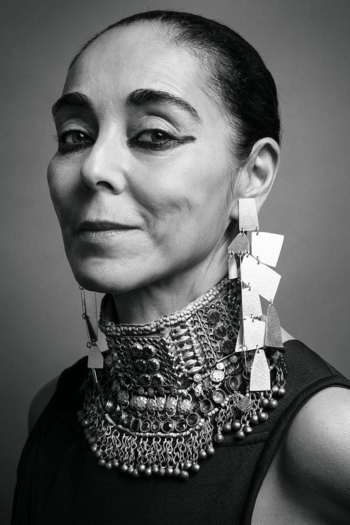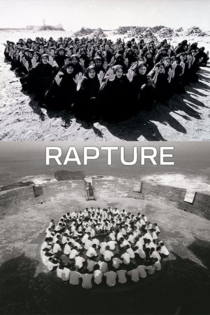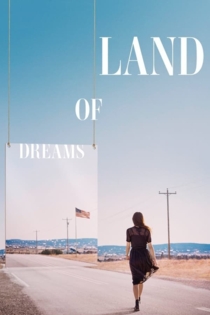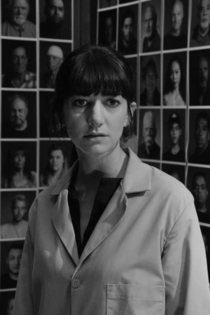
Shirin Neshat
1957 (68 лет)Rapture
Shirin Neshat
The installation features two black-and-white projections. One depicts a group of men dressed in Western suits and the other captures a group of women veiled in chador. In the work, Neshat takes on entrenched gender stereotypes by placing the men in a structured, architectural fortress and the women in a wild, natural desert. The viewer is positioned between these dichotomies, with the videos displayed on opposite walls, and is forced to shift attention from one to the other. The installation shows how established beliefs and presumptions can flourish in social and religious systems, emphasizing that these deep-rooted dynamics profoundly impact all people, indiscriminate of gender.
Rapture

Tooba
Shirin Neshat
Her poetic two-channel video installation Tooba is based on the Koran, in which Tooba, the sacred tree of paradise, offers shelter and sustenance to those in need. Neshat's video places a woman within a groove in the trunk of a large fig tree, symbolising its soul. They stand, alone, in a stone-walled garden set in a mountainous landscape. Men and women draw near and enter the enclosure, seeking refuge, as the Tooba-woman disappears into the Tooba-tree. The piece is ambiguous. Who has agency? Is it the crowd, who 'invade' the garden or the tree-woman who draws them towards her like a magnet? Tooba is dedicated to Iranian writer Shahrnush Parsipour, whose novel Women without Men concerns five women sojourning in a garden, one of whom is transformed into a tree.
Tooba

Turbulent
Shirin Neshat
Shoja Azari, Sussan Deyhim
On one wall, a singer delivers a passionate love song to a group of men. He is faced away from his audience, secure that his performance will be accepted and adored. On the opposite wall, a woman in a black chador stands silently throughout his song. Then something stunning happens…
Turbulent

Soliloquy
Shirin Neshat
Shirin Neshat
Two screens face each other in a dark room, only a bench off to the side interrupting the space between them. Settling into this interstitial expanse of Shirin Neshat’s Soliloquy (1999), viewers become mediators, with the series of scenes on each screen flowing not past, but through this audience – asking them, perhaps, to act as witnesses to the ensuing visual dialogue. The titles begin, in English and Persian; then, the sole character appears, clad in black robes and played by Neshat herself. She is looking out of two different windows: one in Albany, New York; the other in Mardin, Turkey, not far from the artist’s native Iran.
Soliloquy

Women Without Men
Shoja Azari, Shirin Neshat
Shabnam Toloui, Pegah Ferydoni
Against the tumultuous backdrop of Iran's 1953 CIA-backed coup d'état, the destinies of four women converge in a beautiful orchard garden, where they find independence, solace and companionship.
Women Without Men

Venice 70: Future Reloaded
Franco Maresco, John Akomfrah
Bernardo Bertolucci, Haile Gerima
Made for the Venice Film Festival's 70th anniversary, seventy filmmakers made a short film between 60 and 90 seconds long on their interpretation of the future of cinema.
Venice 70: Future Reloaded

Illusions & Mirrors
Shirin Neshat
Tarek Aylouch, Michael Markiewicz
ILLUSIONS and MIRRORS is about the futile attempt of chasing a shadow that wanders through the dunes of an empty beach. When it finally comes to an encounter in a deserted house, the young woman experienced a disturbing surprise.
Illusions & Mirrors

Looking for Oum Kulthum
Shoja Azari, Shirin Neshat
Neda Rahmanian, Yasmin Raeis
A film within a film, "Looking for Oum Kulthum" is the plight of an Iranian woman artist/filmmaker living in exile, as she embarks on capturing the life and art of the legendary female singer of the Arab world, Oum Kulthum. Through her difficult journey, not unlike her heroine's, she has to face the struggles, sacrifices and the price that a woman has to pay if she dares to cross the lines of a conservative male dominated society.
Looking for Oum Kulthum

Land of Dreams
Shoja Azari, Shirin Neshat
Sheila Vand, Matt Dillon
Simin is an Iranian woman on a journey to discover what it means to be a free American. She works for the Census Bureau which, in an effort to control its citizens, has begun a program to record their dreams. Unaware of this devious plot, Simin is torn between her compassion for those whose dreams she is recording and a truth she must find within.
Land of Dreams





